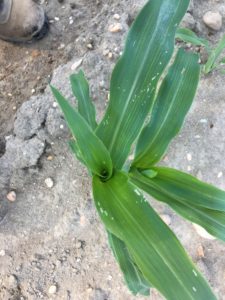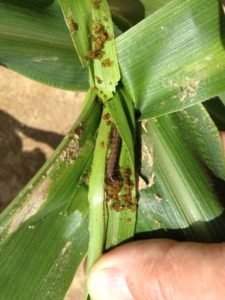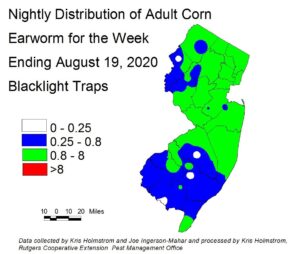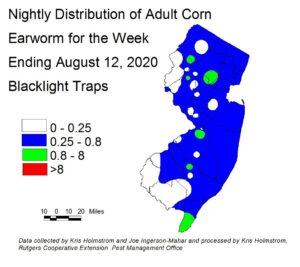Sweet Corn
European corn borer (ECB) adults remain very low, and no map will appear in this edition.
The highest nightly trap catches of ECB for the week ending 8/19/20 are as follows:
| Downer 1 |
| Matawan 1 |

 Fall armyworm (FAW) larval infestations continue at a fairly steady rate, except for coastal Monmouth County, where infestations exceeding 60% were found in whorl and seedling stage sweet corn. This infestation was likely associated with the tropical storm of two weeks ago. FAW could increase dramatically with the arrival of these storms, resulting in significant injury to whorl and even seedling stage corn. Injury from newly hatched larvae shows up as “window panes” or areas where leaf tissue has been eaten down the the lower epidermis (see photo at far left). This injury leads down into the whorl. As larvae gain size, they begin to consume leaf tissue in its’ entirety, creating ragged holes and lots of droppings (see photo at near left). FAW can be tough to manage because it is resistant to synthetic pyrethroid insecticides (IRAC 3A) and because larvae are often covered by their own droppings, making contact with the insecticide more difficult. Treat when 12% or more plants exhibit FAW injury alone, or in combination with ECB injury.
Fall armyworm (FAW) larval infestations continue at a fairly steady rate, except for coastal Monmouth County, where infestations exceeding 60% were found in whorl and seedling stage sweet corn. This infestation was likely associated with the tropical storm of two weeks ago. FAW could increase dramatically with the arrival of these storms, resulting in significant injury to whorl and even seedling stage corn. Injury from newly hatched larvae shows up as “window panes” or areas where leaf tissue has been eaten down the the lower epidermis (see photo at far left). This injury leads down into the whorl. As larvae gain size, they begin to consume leaf tissue in its’ entirety, creating ragged holes and lots of droppings (see photo at near left). FAW can be tough to manage because it is resistant to synthetic pyrethroid insecticides (IRAC 3A) and because larvae are often covered by their own droppings, making contact with the insecticide more difficult. Treat when 12% or more plants exhibit FAW injury alone, or in combination with ECB injury.
 Corn earworm (CEW) moth captures have increased significantly in central and northern New Jersey blacklight traps over the past week. This moderate mid-Summer population poses a significant risk to silking corn. Catches remain somewhat variable (see map at left), with green areas on this map representing a 3-day spray schedule. Note that there continues to be disagreement between blacklight and pheromone trap maps with regard to the southwestern counties. See pheromone trap information below.
Corn earworm (CEW) moth captures have increased significantly in central and northern New Jersey blacklight traps over the past week. This moderate mid-Summer population poses a significant risk to silking corn. Catches remain somewhat variable (see map at left), with green areas on this map representing a 3-day spray schedule. Note that there continues to be disagreement between blacklight and pheromone trap maps with regard to the southwestern counties. See pheromone trap information below.
The highest nightly trap catches of CEW in black light traps for the week ending 8/19/20 are as follows:
| Bellemeade 5 | Lawrenceville 3 | Matawan 2 |
| Morristown 3 | Georgetown 2 | New Egypt 2 |
| Princeton 3 | Hackettstown 2 | Pennington 2 |
| Allamuchy 3 | Hillsborough 2 | South Branch 2 |


